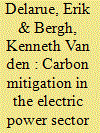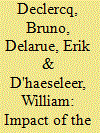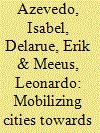|
|
|
Sort Order |
|
|
|
Items / Page
|
|
|
|
|
|
|
| Srl | Item |
| 1 |
ID:
150458


|
|
|
|
|
| Summary/Abstract |
In Europe, CO2 emissions from the electric power sector and energy intensive industries are capped under a cap-and-trade system (i.e., the EU ETS). When other indirect measures are taken to impact emissions in a specific sector under the cap (such as a push for renewables in the electric power sector), this has implications on the overall allowance price, and on CO2 emissions both from this specific sector and the other sectors under the cap. The central contribution of this paper is the derivation of impact curves, which describe these interactions, i.e., the impact on allowance price and the shift of emissions across sectors. From a set of detailed simulations of the electric power system operation, a so-called “emission plane” is obtained, from which impact curves can be derived. Focus is on interactions between CO2 abatement through fuel switching and measures affecting the residual electricity demand (such as deployment of renewables) in the electric power sector, as well as on interactions with other sectors, both in a short-term framework. A case study for Central-Western Europe is presented. The analysis reveals a substantial impact of renewables on CO2 emissions, and hence on emissions shifts across sectors and/or on the CO2 price.
|
|
|
|
|
|
|
|
|
|
|
|
|
|
|
|
| 2 |
ID:
126600


|
|
|
|
|
| Publication |
2013.
|
| Summary/Abstract |
As of 2005, electricity generators in Europe operate under the European Union Emission Trading System (EU ETS). At the same time, European Member States have launched support mechanisms to stimulate the deployment of renewable electricity sources (RES-E). RES-E injections displace CO2 emissions within the sectors operating under the EU ETS and they reduce the demand for European Union Allowances (EUAs), thereby reducing the EUA price. This paper presents the results of an ex post analysis to quantify the impact of RES-E deployment on the EUA price and CO2 emissions in the Western and Southern European electricity sector during the period from 2007 to 2010, following from an operational partial equilibrium model of the electricity sector. This study shows that the CO2 displacement from the electricity sector to other ETS sectors due to RES-E deployment can be up to more than 10% of historical CO2 emissions in the electricity sector. The EUA price decrease caused by RES-E deployment turns out to be likely significant.
|
|
|
|
|
|
|
|
|
|
|
|
|
|
|
|
| 3 |
ID:
103469


|
|
|
|
|
| Publication |
2011.
|
| Summary/Abstract |
This paper investigates the impact of the economic recession on CO2 emissions in the European power sector, during the years 2008 and 2009. Three main determinants of the power sector's emissions are identified: the demand for electricity, the CO2 price, and fuel prices. A counterfactual scenario has been set up for each of these, i.e., what these parameters would have been if not affected by the recession. A simulation model of the European power sector is then employed, comparing a historical reference simulation (taking the parameters as actually occurred) with the counterfactual scenarios. The lower electricity demand (due to the recession) is shown to have by far the largest impact, accounting for an emission reduction of about 175 Mton. The lower CO2 price (due to the recession) resulted in an increase in emissions by about 30 Mton. The impact of fuel prices is more difficult to retrieve; an indicative reduction of about 17 Mton is obtained, mainly as a consequence of the low gas prices in 2009. The simulated combined impact of the parameters results in an emission reduction of about 150 Mton in the European power sector over the years 2008 and 2009 as a consequence of the recession.
|
|
|
|
|
|
|
|
|
|
|
|
|
|
|
|
| 4 |
ID:
124229


|
|
|
|
|
| Publication |
2013.
|
| Summary/Abstract |
The combination of the ambitious German greenhouse gas reduction goals in the power sector and the nuclear phase-out raises many questions concerning the operational security of the German electricity generation system. This paper focusses on the technical feasibility (electricity generation and transmission) and CO2-impact of the German nuclear phase-out on the short term (2012-2022).
A detailed electricity generation simulation model is employed, including the German transmission grid and its international connections. A range of different conventional and renewable energy sources (RES) scenarios is considered. Results are presented for the change in generation mix, on the flows on the transmission network and on operational reliability issues.
The scenario analysis shows that nuclear generation will be replaced mainly by coal- and lignite-based generation. This increases the CO2-intensity of the German electricity sector. Furthermore, the results indicate that the German electricity export will decrease and under certain circumstances, the system becomes infeasible. Keeping some nuclear power plants online, would mitigate these effects. The amount of electricity generated from RES is shown to be the main driver for grid congestion.
|
|
|
|
|
|
|
|
|
|
|
|
|
|
|
|
| 5 |
ID:
092798


|
|
|
|
|
| Publication |
2009.
|
| Summary/Abstract |
As Europe wants to move towards a secure, sustainable and competitive energy market, it has taken action, amongst other, to support electricity from renewable energy sources (RES-E) and to mitigate CO2 emissions. This paper first qualitatively discusses price- and quantity-based measures for RES-E deployment as well as CO2 mitigation. Next, a simulation model is developed to quantitatively discuss the effects of a tradable green certificate system, a premium mechanism, a tradable CO2 allowance system and a CO2 tax on both RES-E deployment and CO2 mitigation. A three-regional model implementation representing the Benelux, France and Germany is used. In a first step of simulations, all measures are implemented separately. In a second step, combinations of both RES-E supporting and CO2 mitigating measures are simulated and discussed. Significant indirect effects are demonstrated, especially for RES-E supporting measures on the reduction of CO2 emissions. Interactions between different measures show that the price level of quantity-based measures can be strongly influenced.
|
|
|
|
|
|
|
|
|
|
|
|
|
|
|
|
| 6 |
ID:
125596


|
|
|
|
|
| Publication |
2013.
|
| Summary/Abstract |
In the transition towards a low-carbon future in Europe, cities' actions are of major importance due to the prominence of urbanization, both in terms of population and in terms of greenhouse gas (GHG) emissions. As a result, we need city authorities to act, by using their competences as policy makers as well as energy users. However, cities are still not moving as fast as one might expect, indicating the need for additional incentives to prompt local action. Therefore, the aim of this paper is to present an overview of external incentives that might prompt cities to act and to highlight good practices that could be used in future initiatives.
This paper first discusses how to evaluate the climate and energy performance of a city and how local authorities can contribute to its improvements. Moreover, it analyses the disincentives that local governments are confronted with, categorizing them as simple market failures, institutional failures and multi-agent failures. The paper then presents a survey of initiatives at national and EU levels to promote local action towards a low-carbon future; grouping them into tambourines, carrots and sticks. We focus on Austria, Germany, the Netherlands and Sweden because they are pioneering countries regarding energy policies for cities.
|
|
|
|
|
|
|
|
|
|
|
|
|
|
|
|
| 7 |
ID:
103455


|
|
|
|
|
| Publication |
2011.
|
| Summary/Abstract |
Electricity storage is considered as a valuable source of flexibility with applications covering the whole electricity value chain. Most of the existing evaluation methods for electricity storage are conceived for one specific use of the storage, which often leads to the conclusion that the investment on storage does not pay off. However, the value of storage cannot be properly estimated without taking into account the possibility of aggregating the services that storage can offer to different actors. This paper proposes a new business model that allows aggregating multiple revenue streams of electricity storage in a systematic way. The model consists in coordinating a series of auctions in which the right to utilize the storage unit is auctioned upon different time horizons. In the mean time, non-conflicting usage of storage by the actors in these different auctions is ensured. The functioning of the model is demonstrated by a case study. The results show that a storage unit can achieve higher return on investment in the manner proposed in the business model.
|
|
|
|
|
|
|
|
|
|
|
|
|
|
|
|
|
|
|
|
|